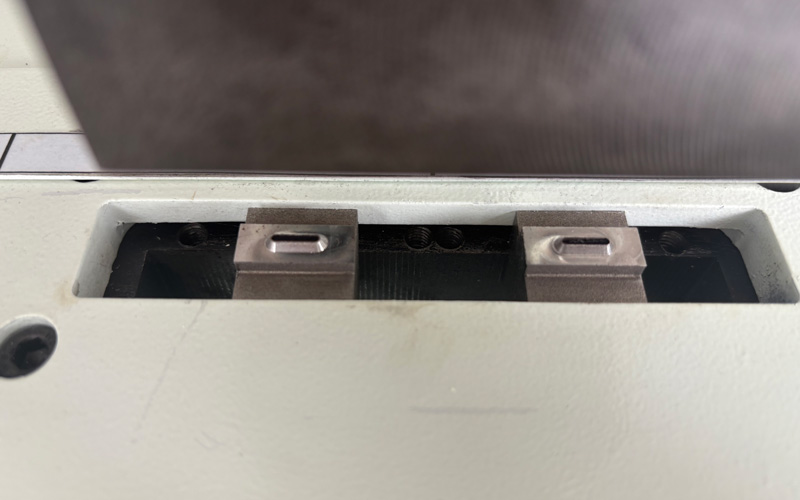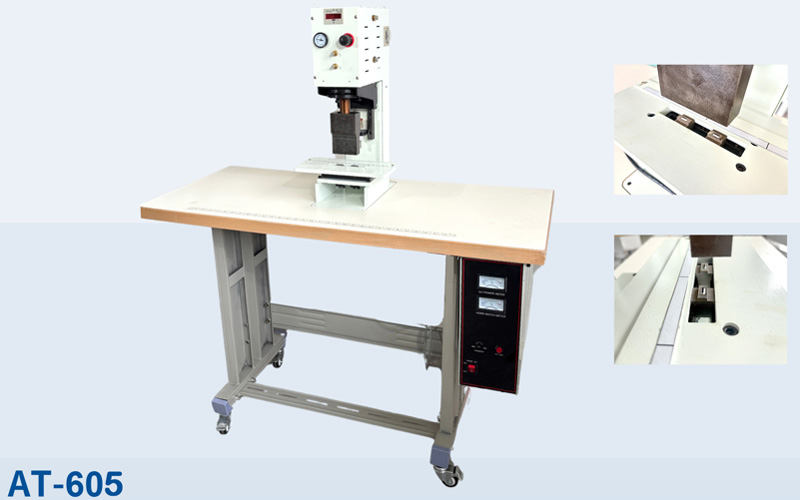In the rapidly evolving world of garment manufacturing, the need for precision, speed, and consistency is more pressing than ever. One of the key innovations revolutionizing this field is the Ultrasonic Button Holes Punching Machine—a modern solution that produces smooth, durable buttonholes without damaging the fabric.
But how does this machine work? How does it manage to create perfect buttonholes in just milliseconds without burning, fraying, or tearing the textile? In this in-depth blog post, we’ll explore the working principle, internal components, ultrasonic technology, and practical applications of this advanced machine.
Whether you’re a factory owner, an equipment distributor, or simply curious about garment machinery, this article will help you fully understand how ultrasonic punching works and why it’s transforming apparel production lines worldwide.
1. Introduction to Ultrasonic Button Hole Technology
Traditional methods for cutting buttonholes—such as mechanical punching or laser cutting—often struggle with drawbacks like fabric distortion, burnt edges, and low productivity. Enter the Ultrasonic Button Holes Punching Machine: a technology that uses high-frequency ultrasonic vibrations to cleanly cut and seal buttonholes on fabrics like cotton, polyester, and blended materials.
This process is non-contact, clean, and environmentally friendly, and it’s now becoming the standard in industries focused on formal wear, POLO shirts, uniforms, and fashion garments.
2. Key Components of the Ultrasonic Button Holes Punching Machine
Before diving into the process, it’s essential to understand the key parts that make up the machine:
a. Ultrasonic Generator
The ultrasonic generator (or power supply) converts electrical energy into a high-frequency signal, typically 18 kHz or 20 kHz, and sends this energy to the transducer.
b. Ultrasonic Transducer
This component converts the high-frequency electrical signal into mechanical vibrations. It is the heart of the ultrasonic system and responsible for producing the vibration needed for cutting.
c. Horn (Booster)
The horn amplifies and transfers the mechanical vibrations to the cutting tool or sonotrode. It plays a critical role in ensuring precise, even distribution of ultrasonic energy to the working area.
d. Cutting Mold / Die (Sonotrode)
This is the actual part that comes in contact with the fabric. It is shaped based on the desired buttonhole size and style. The ultrasonic vibrations combined with mechanical pressure from the mold produce the clean cut.
e. Pneumatic Presser Foot
Powered by an air cylinder, the presser foot holds the fabric in place and provides consistent pressure during the punching process. It ensures uniform depth and alignment.
f. Control Panel
A user interface that allows operators to adjust settings such as power, pressure, timing, and vibration frequency.
3. The Working Principle: Step-by-Step Process
Let’s explore how the machine actually performs a buttonhole punch from start to finish:
Step 1: Fabric Placement
The operator places the garment—typically a POLO shirt, formal shirt, or jacket—under the presser foot. The buttonhole location is aligned with the cutting mold using either:
Manual alignment
Pre-programmed markers
Integrated guiding systems
Step 2: Activation and Ultrasonic Vibration Generation
Once aligned, the operator initiates the machine. The ultrasonic generator begins to convert electrical energy into high-frequency signals, usually 18 kHz in the most common models.
These signals travel to the transducer, which converts them into mechanical vibrations at ultrasonic speeds. These are then amplified by the horn and transferred to the cutting mold.
Step 3: Cutting and Sealing
As the sonotrode (cutting mold) vibrates against the fabric under the pressure of the air-driven presser foot, localized heat is generated at the molecular level of the textile fibers.
This heat is not from external temperature, but from friction caused by ultrasonic vibration. As a result:
The fibers melt and fuse at the edges
The hole is cut cleanly in a fraction of a second
The surrounding fabric is sealed, preventing fraying or unraveling
Step 4: Cooling and Retraction
After the cut is made:
The ultrasonic vibration stops
The presser foot retracts
The machine resets for the next punch
The entire cycle usually takes less than 1 second, depending on fabric type and machine speed settings.

4. Why Ultrasonic Cutting Works So Well on Fabric
Ultrasonic energy affects thermoplastic materials (like polyester) and blended fabrics in a way that allows them to melt and fuse at the point of contact, rather than being torn or burned like with other cutting methods.
Key physical principles include:
Localized friction causes heat without damaging nearby fabric
Sealing effect strengthens the edge and prevents loose threads
Low thermal diffusion keeps adjacent material cool and intact
This makes it ideal for sensitive, elastic, or multi-layer fabrics often used in sportswear, uniforms, and fashion apparel.
5. Advantages of Ultrasonic Button Hole Punching
Let’s take a closer look at the clear advantages this technology offers:
a. Seamless and Clean Cuts
Each buttonhole is smooth, burr-free, and perfectly aligned—with no burned fabric or rough edges.
b. High Production Efficiency
One machine can punch hundreds of holes per hour, ideal for mass production lines.
c. Adjustable Molds and Hole Spacing
Manufacturers can customize buttonhole shapes and spacing to meet the needs of different garments.
d. Lower Energy Consumption
Because ultrasonic cutting doesn’t require heating elements, it uses less power compared to traditional thermal or laser cutters.
e. Minimal Maintenance
The non-contact design and fewer moving parts lead to reduced wear and tear, extending the machine’s lifespan.
6. Customization Features and Use Flexibility
Ultrasonic punching machines are often equipped with interchangeable molds, which can be made to fit:
Oval holes
Round holes
Long or keyhole-style buttonholes
Decorative or branded patterns
Hole spacing can also be manually or automatically adjusted, allowing for:
Two-button shirt collars
Multiple buttons on suit sleeves
Closely spaced uniform fasteners
This means a single machine can be used for multiple production lines, reducing equipment costs.
7. Machine Specifications Snapshot
Here’s a typical spec sheet for a standard POLO shirt buttonhole punching machine:
| Specification | Value |
|---|---|
| Presser Foot Mechanism | Air Cylinder Driven |
| Max Power | 2800W |
| Input Voltage | AC 220V (Single Phase) |
| Air Pressure Requirement | 0.5 Mpa |
| Ultrasonic Frequency | 18 kHz |
| Net Weight | 130 kg |
| Gross Weight | 190 kg |
| Packaging Size | 135 × 81 × 150 cm |
These features combine to ensure stability, power efficiency, and precision.
8. Applications in the Garment Industry
Ultrasonic buttonhole machines are not limited to just POLO shirts. They’re widely used for:
Formal shirts with crisp button alignment
Corporate uniforms requiring standardized spacing
Children’s clothing for safety-sealed buttonholes
Light jackets and coats where thick layers must be cleanly punched
Custom-designed clothing with decorative hole patterns
Even fashion brands use ultrasonic machines to achieve flawless finishing on high-end apparel.
9. Safety and Operational Considerations
Though ultrasonic technology is safer than high-temperature cutters or sharp mechanical punches, operators should still follow best practices:
Keep hands clear of the cutting area during operation
Regularly inspect pneumatic lines for leaks
Use only certified, correctly fitted molds
Train workers on adjusting air pressure and timing settings
Some machines also include emergency stop switches, thermal sensors, and overload protection systems for factory-level safety.
10. Maintenance Tips for Long-Term Use
To get the most out of your ultrasonic button holes punching machine:
Clean the horn and cutting die daily
Check for vibration inconsistency and recalibrate when needed
Inspect air filters and valves for dust buildup
Replace molds when worn to maintain clean cutting results
Store machine in a dry, temperature-controlled environment
With proper care, these machines can last 5-10 years with minimal part replacement.
Conclusion: Ultrasonic Punching – The Future of Buttonholes
The Ultrasonic Button Holes Punching Machine represents a leap forward in textile manufacturing technology. By harnessing the power of high-frequency vibration, it offers garment makers:
Unparalleled cutting precision
Seamless, sealed buttonholes
Speed and efficiency for high-volume production
Reduced labor and maintenance needs
Understanding how this machine works—from its internal components to the ultrasonic cutting principle—reveals why it’s becoming a standard in factories worldwide, especially for POLO shirts, uniforms, and premium garments.

Want to Learn More or Get a Quote?
If you’re considering integrating ultrasonic cutting into your production line, Alster can help:
Schedule a demo
Request machine customization options
Get pricing with freight and packaging included
Upgrade your production with ultrasonic precision. Clean cuts. No fray. No scorch. Just perfection.
